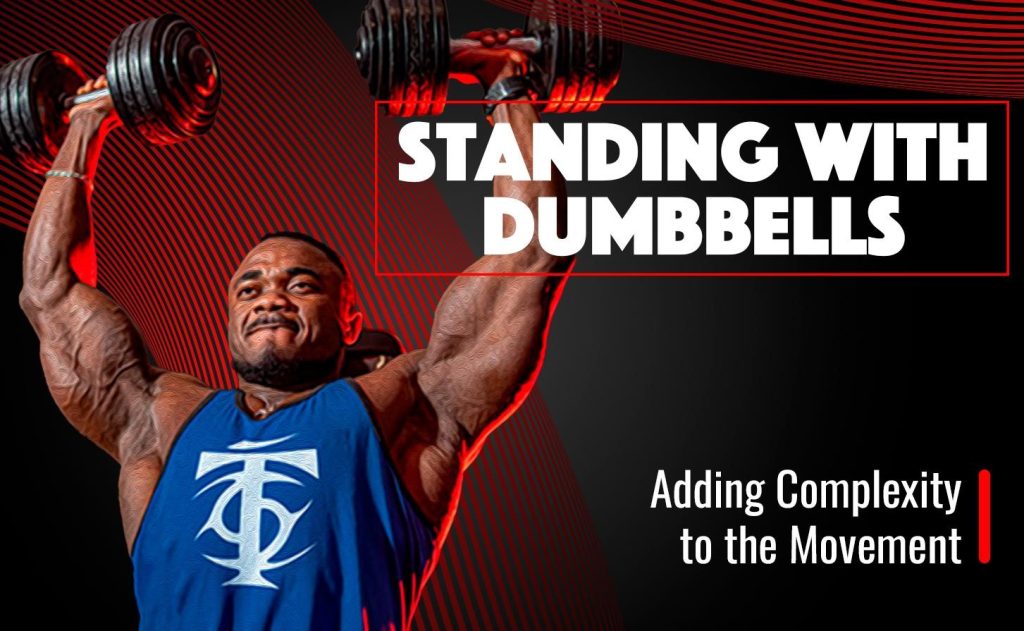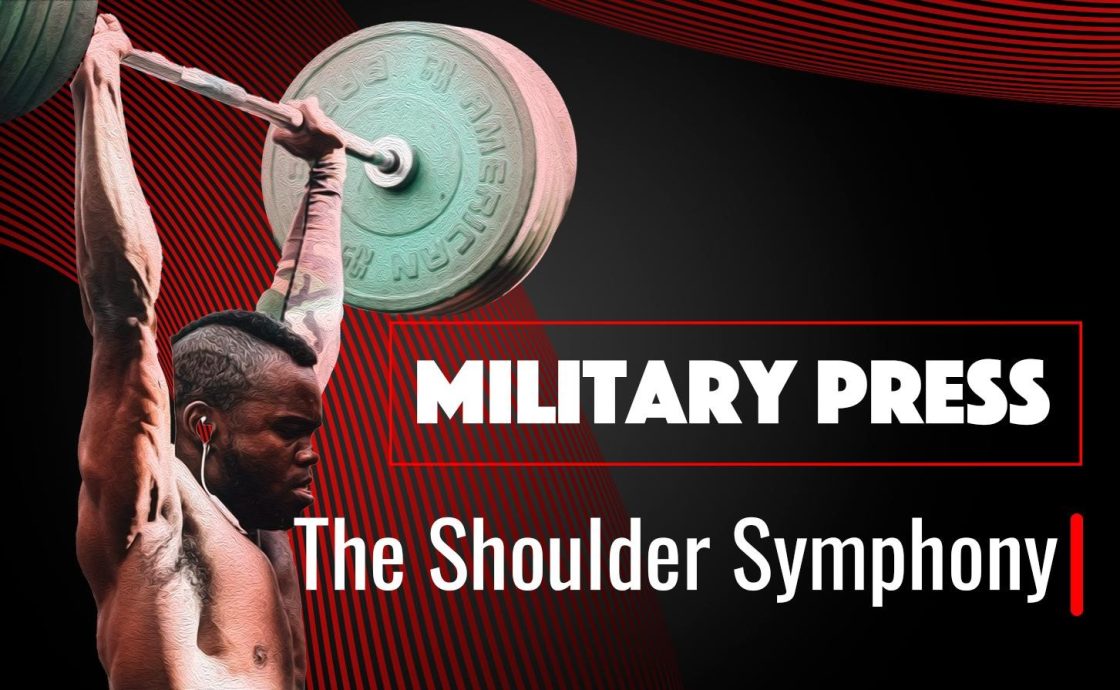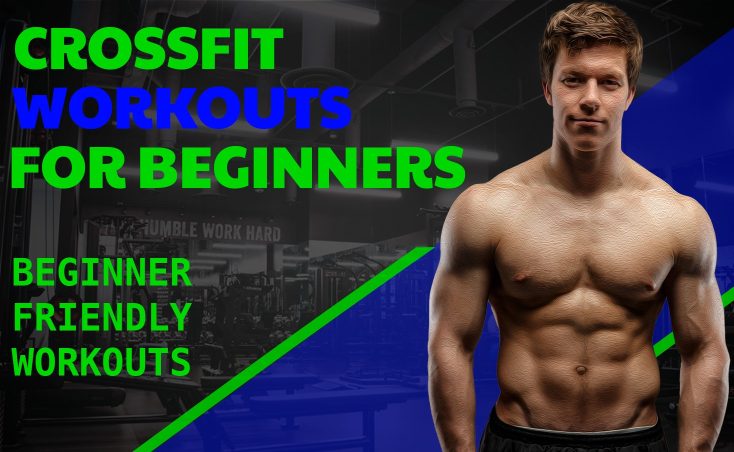Discover the rewards of incorporating the military press into your workout routine, and learn how to prevent injuries by avoiding common mistakes and prioritizing warm-up and stretching. With proper nutrition and recovery, you’ll pave the way for success and crush the misconceptions surrounding this powerful exercise. Let’s unlock the full potential of the military press and embark on a journey towards a stronger, more sculpted physique!
What is the Military Press?
Are you ready to discover a fantastic exercise for building strong shoulders? Let’s talk about the military press! It’s a simple but effective workout that targets your upper body muscles, especially your shoulders, triceps, and chest. The goal is to lift a barbell or dumbbells from your shoulders and push them overhead.
The military press has evolved over time. In the past, people used to do it while sitting, but nowadays it’s more common to perform it while standing. This way, you engage not only your shoulder muscles but also your core and lower body. It’s a great exercise for developing well-defined shoulders, boosting your upper body strength, and even improving your posture. If you want to take your shoulders to the next level and achieve a stronger upper body, the military press is definitely worth trying. It’s a straightforward and efficient exercise that can help you achieve your fitness goals.
The Evolution from Seated to Standing Military Press: A Historical Perspective
Let’s take a journey back in time to explore how the military press has evolved from a seated position to a standing one. In the past, people used to perform the military press while sitting down. It was a common practice that allowed them to lift weights from their shoulders and push them overhead.
Over the years, fitness enthusiasts and athletes began experimenting with different variations of the military press. They found that by performing the exercise while standing, they could engage more muscles and make the movement more challenging. This evolution from seated to standing added a new dimension to the exercise and brought about additional benefits.
By standing while doing the military press, individuals not only target their shoulder muscles but also involve their core and lower body. This engagement of multiple muscle groups results in a more comprehensive workout, leading to improved overall strength and stability.
Activate Every Fiber: Unleashing the Military Press Muscles Worked
The military press is not just a shoulder exercise; it engages multiple muscle groups, activating every fiber in your upper body. When you perform the military press, you put your shoulders, triceps, and chest to work, resulting in a synergistic movement that strengthens your upper body as a whole. This exercise is a true powerhouse for building strength and muscle.
Delve into the Front Deltoids: Targeting the Key Muscle Group
One of the primary muscle groups targeted during the military press is the front deltoids. These muscles, located at the front of your shoulder, play a crucial role in moving your arms overhead.
By engaging the front deltoids during the military press, you can develop well-rounded and defined shoulders. It’s important to focus on proper form and control to ensure maximal activation of this key muscle group.
Engage the Triceps: Unlocking the Hidden Potential of Arm Strength
Another significant military press muscles worked are the triceps. While the shoulders take the spotlight, the triceps, located at the back of your upper arm, shouldn’t be overlooked.
By extending your elbows during the upward phase of the military press, you engage the triceps, helping to strengthen and define the back of your arms. This exercise provides a fantastic opportunity to unleash the hidden potential of your arm strength.
Strengthen the Upper Chest: Leveraging the Secondary Muscle Group
In addition to the primary muscle groups, the military press also targets the upper chest as a secondary muscle group. While the emphasis is on the shoulders, the upper chest muscles, such as the pectoralis major, come into play during the pressing movement.
Strengthening the upper chest not only contributes to an impressive physique but also enhances overall upper body strength. By performing the military press correctly, you can leverage this secondary muscle group and achieve even greater results in your upper body development.
Improve Posture and Core Stability: The Underrated Perks
One of the often-overlooked benefits of the military press muscles worked is the core. Its positive impact on your posture is underrated. As you perform this exercise, you engage the muscles in your upper back, including the rhomboids and trapezius. These muscles play a vital role in maintaining proper posture and preventing slouching.
Another underrated perk of the military press is its ability to improve core stability. Your core muscles, including the abdominals, obliques, and lower back muscles, play a crucial role in maintaining stability and supporting your spine. During the military press, engaging your core is essential for generating power and maintaining control as you lift the weight.
Mastering the Perfect Form: Secrets to a Flawless Military Press
In this guide, we will look deeper into the secrets of performing the military press flawlessly. By focusing on key aspects such as foot placement, elbow alignment, and initiating the movement with precision, you can optimize your performance, prevent injuries, and maximize military press muscles worked.
A Firm Foundation: Proper Foot Placement and Stability
When it comes to mastering the perfect form for the military press, a firm foundation is essential. This foot placement provides the stability you need to generate power and maintain balance throughout the exercise. Remember, a strong foundation sets the stage for a flawless military press.
- Start by standing with your feet shoulder-width apart, ensuring a stable base to support the weight you’re about to lift.
- Keep your weight evenly distributed, engaging both your toes and heels.
Elbows in Alignment: Optimizing Joint Health and Performance
To perform the military press with precision, it’s crucial to pay attention to the alignment of your elbows. By focusing on proper alignment, you can prevent injuries and optimize the effectiveness of the military press.
- As you lift the weight, ensure that your elbows are positioned directly under the bar or the dumbbells. This alignment optimizes joint health by distributing the load evenly and minimizing unnecessary stress.
- Additionally, keeping your elbows in line with your wrists promotes better performance, allowing you to generate maximum power and maintain control.
Overhead Power: Initiating the Movement with Precision
Initiating the movement for the military press with precision is key to mastering its perfect form. Initiating the movement with precision ensures that you engage the targeted muscle groups effectively and maximize the benefits of the military press.
- Start by gripping the bar or dumbbells slightly wider than shoulder-width apart, with your palms facing forward.
- As you prepare to lift, engage your core and glutes, creating a solid foundation of strength.
- Drive the weight upwards, exhaling as you extend your arms fully overhead.
- Generate power from your shoulders and exert control throughout the entire range of motion.
Protect and Strengthen: Taking Precautions during Military Press Training
When it comes to training for the military press, it’s important to not only focus on building strength and muscle, but also to prioritize safety and prevent potential injuries. We will discuss some common mistakes to avoid in order to ensure safe and effective lifts. By being aware of these pitfalls, you can protect yourself and make the most out of your training sessions.
Sacrificing Proper Form for Heavier Weights
It’s important to prioritize maintaining proper posture, with your core engaged and your spine aligned, to effectively target the intended muscles and prevent strain on other areas of your body.
Using too much Weight too Quickly
While it can be tempting to push your limits, it’s essential to start with a weight that allows for proper technique and gradually increase the load as your strength and form improve. Remember, progress is a journey, and it’s better to focus on quality lifts rather than solely focusing on the numbers.
Disregarding any signs of Discomfort or Pushing through Pain
Pay close attention to your body and listen to any warning signs. Rest and allow yourself proper recovery time to prevent more serious injuries that can set you back in your training.
Proper Warm-up and Mobility Exercises: Set Yourself Up for Success
Warm-up exercises help increase blood flow, raise your body temperature, and improve flexibility, reducing the chance of strains or other injuries. These exercises will maximize the military press muscles worked.
- Start with a brief cardio warm-up, such as brisk walking or light jogging, to get your heart rate up and warm up your whole body.
- Once your body is warmed up, it’s beneficial to incorporate mobility exercises that specifically target the muscles involved in the military press. These exercises can help increase your range of motion and improve your overall performance. Focus on dynamic movements that mimic the motion of the military press, such as arm circles or shoulder rotations, to activate and loosen up your shoulder and upper back muscles.
- Remember to start slowly and gradually increase the intensity of your warm-up and mobility exercises. If you feel any pain or discomfort, scale back or modify the movement to prevent any potential injuries.
Push Beyond the Limit: Exploring Variations of the Military Press
When it comes to pushing your upper body strength to new heights, the military press is a go-to exercise. However, did you know that there are variations of the military press that can take your workout to another level? So, let’s dive in and discover the techniques that will push you beyond your limits!
The Seated Military Press: A Different Take on the Classic
As the name suggests, this variation involves performing the exercise in a seated position, which adds an element of stability and control to the movement.
- By sitting on a bench or a sturdy surface, you eliminate any lower body involvement and solely focus on engaging your shoulders, triceps, and upper chest.
- Not only does the seated military press target the same muscle groups as the standing version, but it also allows you to isolate and strengthen them even further.

Standing with Dumbbells: Adding Complexity to the Movement
When it comes to challenging your muscles and enhancing your overall strength, standing military press with dumbbells is a game-changer. Unlike the traditional barbell military press, this variation requires you to use dumbbells, which adds complexity and instability to the exercise.
- By holding dumbbells in each hand, you engage more stabilizer muscles in your shoulders and arms, making the movement more challenging and effective.
- Additionally, the individual control of each dumbbell allows for a greater range of motion and helps to address any muscle imbalances.
The Arnold Press Twist: Reigniting the Upper Body Challenge
The Arnold press twist is the answer. Named after the legendary bodybuilder Arnold Schwarzenegger, this variation adds a unique twist (literally!) to the traditional military press. The Arnold press twist is a fantastic way to reignite the upper body challenge and keep your muscles guessing.
- Start by holding dumbbells at shoulder level, palms facing your body.
- As you press the weights upward, rotate your palms outward, ending with your palms facing forward at the top of the movement. This twisting motion engages your muscles in a different way, challenging your stability and activating additional muscle fibers.
Incorporating the Military Press into Your Routine
If you’re looking to add this exercise to your routine, it’s important to do so in a strategic and effective manner. In this guide, we will discuss strategies to seamlessly integrate the military press into your workout plan
Designing Your Workout Plan: Strategies to Seamlessly Integrate the Military Press
Before incorporating the military press into your routine, it’s essential to design a well-rounded workout plan that addresses your overall fitness goals.
- To avoid overtraining and ensure proper muscle recovery, it’s recommended to plan for at least two to three days of rest or alternative exercises targeting different muscle groups. This allows your muscles to repair and grow stronger.
- You can split your routine into different workout sessions, focusing on specific muscle groups. For example, you can dedicate one day to chest and triceps exercises, another day to back and bicep exercises, and reserve a day specifically for shoulder and upper back training, which includes the military press.
- This allows you to prioritize each muscle group and give them the attention they need, promoting balanced development and reducing the risk of overuse injuries.
Splitting the Routine: Planning for Upper Body Strength
To effectively plan your upper body strength training sessions, it’s important to incorporate a variety of exercises that target different muscle groups.
- Alongside the military press, you can include compound movements like bench press or push-ups, which engage multiple muscle groups simultaneously.
- Additionally, incorporating isolation exercises such as lateral raises or tricep dips can further enhance muscle development and stabilization.
- Remember, proper form and technique are key to any exercise. It’s crucial to start with lighter weights and gradually increase the load as you improve your strength and form.
- Additionally, ensure that you’re allowing yourself enough time for rest between sets to optimize muscle recovery and minimize the risk of fatigue-related injuries.
Superset and Compound Movements: Maximizing Time Efficiency
For those looking to optimize their time in the gym, incorporating supersets and compound movements into your upper body workout can be highly effective. Supersets involve performing two exercises back-to-back with little to no rest in between. This helps to keep your heart rate elevated, maximize calorie burn, and increase overall workout efficiency.
- For instance, you can pair the military press with a tricep pushdown or lateral raise, targeting different muscle groups and giving your workout an added intensity.
- Similarly, compound movements, such as push-ups or pull-ups, engage multiple muscle groups at once, allowing you to work efficiently and save time.
- These exercises can be combined with the military press to create a well-rounded upper body workout that promotes strength and muscle development.
Nutrition and Recovery
When it comes to achieving fitness goals, proper nutrition and recovery play a crucial role in maximizing your performance and progress. This is especially true when it comes to exercises like the military press, which requires significant upper body strength.
Support Your Goals: Proper Nutrition to Enhance Military Press Performance
The right nutrition regimen is essential for building muscle, promoting strength development, and achieving your overall fitness goals.
- Consuming adequate macronutrients such as carbohydrates, proteins, and healthy fats helps to support muscle growth and repair, as well as providing the energy your body needs for lifting.
- To enhance your military press performance, it’s important to consume enough calories and protein to fuel your muscle growth and recovery. Adequate carbohydrates are also essential to provide energy for muscle contractions.
- Additionally, ensure that you stay hydrated throughout your workouts. Proper hydration promotes optimal digestion, nutrient absorption, and muscle flexibility.
Fuel Your Body: Macronutrient Considerations for Muscle Growth
Your macronutrient intake has a huge impact on your body’s ability to build and repair muscle tissue.
- Protein is a key nutrient for muscle growth, which is why many strength athletes and bodybuilders focus on consuming high amounts of protein. As a general guideline, aim to consume at least 1 gram of protein per pound of body weight per day. This ensures that your body has the necessary building blocks for muscle repair and growth.
- Carbohydrates are also essential for energy, which is why it’s important to consume the right amount of carbs for your activity level. Eating carbs before and after workouts can help to enhance energy levels and promote muscle recovery.
- Healthy fats are essential for maintaining hormone balance and overall health. Incorporating healthy fats like avocados, nuts, and seeds into your diet can help to support optimal hormone regulation and promote muscle growth.
Recovery is Key: The Role of Rest and Proper Sleep
On top of consuming the proper nutrients, recovery is equally important for muscle growth and performance optimization. Getting adequate rest and allowing your muscles enough time to recover is necessary for avoiding injury and promoting optimal progress.
- One strategy is to alternate between lower intensity workouts and high-intensity workouts, allowing your muscles enough time to recover from the intense training sessions.
- Proper sleep is also crucial for recovery. Aim for at least 7-9 hours of sleep every night to optimize muscle regeneration and hormone regulation.
Debunking the Myths: Clarifying Common Misconceptions about the Military Press
The military press is a popular upper body exercise that many individuals aspire to master. However, there are several misconceptions surrounding this exercise that can hinder progress and lead to misinformation.
Myth #1: Military Press is Only for Bulking Up
One common misconception about the military press is that it is primarily for individuals looking to bulk up and build massive shoulders. While it’s true that the military press targets the shoulder muscles, it is a versatile exercise that can benefit individuals with different fitness goals.
- Whether your goal is to gain muscle mass, increase strength, or improve athletic performance, the military press can be a valuable addition to your training routine.
Myth #2: Military Press is Dangerous for the Shoulders
While any exercise carries a certain level of risk if performed with improper form or excessive weight, the military press itself is not inherently dangerous.
- Proper form and technique are crucial to prevent injuries when performing the military press. It’s important to maintain a neutral spine, engage the core for stability, and lift with controlled movements.
- Starting with lighter weights and gradually increasing the load as you build strength and confidence is key.
- Additionally, incorporating proper warm-up exercises and shoulder mobility drills before performing the military press can help reduce the risk of injury.
Myth #3: Military Press is the Only Shoulder Exercise You Need
Some believe that the military press is the be-all and end-all exercise for shoulder development. However, this is a misconception as an effective shoulder workout should incorporate a variety of exercises targeting different areas of the shoulder muscles.
- While the military press is excellent for overall shoulder strength, incorporating additional exercises such as lateral raises, front raises, and rear deltoid exercises can help target specific areas of the shoulder.
- By incorporating various shoulder exercises into your routine, you can promote balanced shoulder development and reduce the risk of muscle imbalances.
Myth #4: Seated Military Press is Better
Another common myth surrounding the military press is that the seated variation is superior to the standing variation. While both exercises target similar muscle groups, it is important to understand the differences and benefits of each variation.
- Seated military press is often favored for its perceived stability and reduced strain on the lower back. It allows you to focus solely on upper body strength without having to engage your core and lower body for balance.
- However, standing military press offers unique advantages that can contribute to overall strength and athleticism. By performing the exercise in a standing position, you engage more muscles, including the core, lower back, and legs, to stabilize your body during the movement.
- Ultimately, the choice between standing and seated military press depends on your specific goals and needs.
- If you are looking to isolate and focus primarily on building upper body strength or if you have specific limitations, the seated military press may be a suitable option.
- On the other hand, if you want to enhance overall strength, stability, and coordination, incorporating the standing military press can provide additional benefits.



